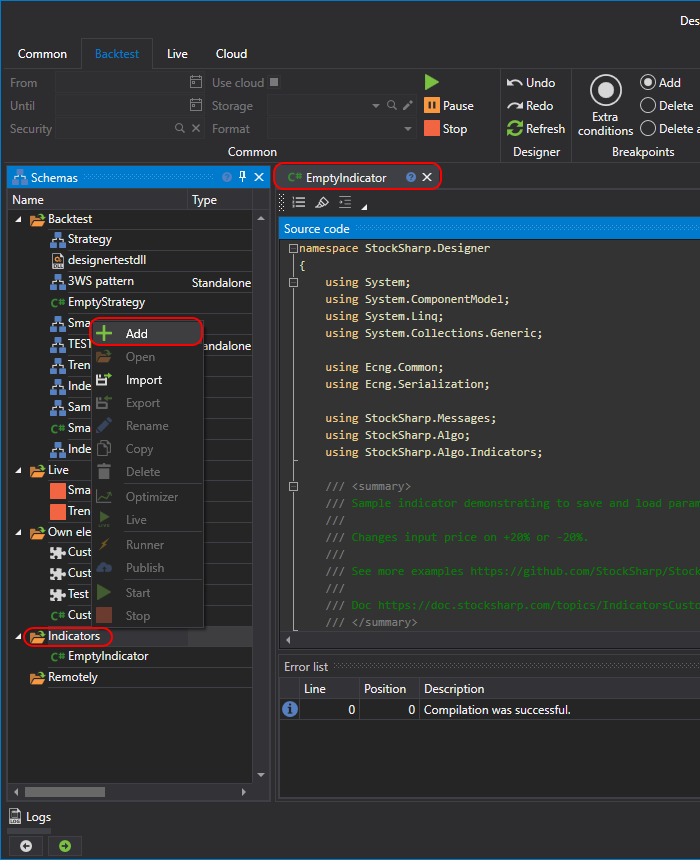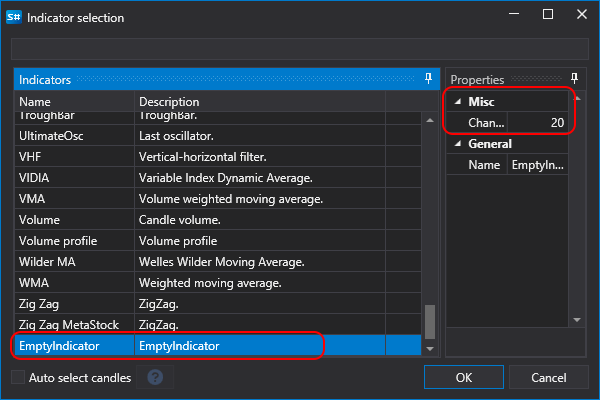Creating an Indicator
Creating a custom indicator in API is described in the Custom Indicator section. Such indicators are fully compatible with Designer.
To create an indicator, you need to select the Indicators folder on the Schemes panel, right-click, and select Add from the context menu:

The indicator code will look like this:
import clr
import random
clr.AddReference("StockSharp.BusinessEntities")
clr.AddReference("StockSharp.Algo")
from StockSharp.Algo.Indicators import BaseIndicator, DecimalIndicatorValue
from indicator_extensions import *
class empty_indicator(BaseIndicator):
"""
Sample indicator demonstrating saving and loading parameters.
Doc https://doc.stocksharp.com/topics/designer/strategies/using_code/python/create_own_indicator.html
Changes input price on +20% or -20%.
"""
def __init__(self):
super(empty_indicator, self).__init__()
self._change = 20
self._counter = 0
self._isFormed = False
@property
def Change(self) -> int:
return self._change
@Change.setter
def Change(self, value):
self._change = value
self.Reset()
def CalcIsFormed(self):
"""Determines if the indicator has received sufficient inputs to be considered formed."""
return self._isFormed
def Reset(self):
"""Resets the indicator's state and internal counters."""
super(empty_indicator, self).Reset()
self._isFormed = False
self._counter = 0
def OnProcess(self, input):
"""
Processes the incoming indicator value and applies a random change.
:param input: The incoming indicator value.
:return: A new DecimalIndicatorValue after applying changes.
"""
# Every 10th call, try to return an empty value
if random.randint(0, 10) == 0:
return DecimalIndicatorValue(self, input.Time)
if self._counter == 5:
# For example, our indicator needs 5 inputs to become formed
self._isFormed = True
self._counter += 1
value = to_decimal(input)
# Apply random change of +/- _change percent to the current value
value += value * random.randint(-self._change, self._change) / 100.0
result = DecimalIndicatorValue(self, value, input.Time)
# Mark value as final based on a random decision
result.IsFinal = bool(random.getrandbits(1))
return result
def Load(self, storage):
"""
Loads the indicator parameters from persistent storage.
:param storage: The settings storage to load from.
"""
super(empty_indicator, self).Load(storage)
self.Change = storage.GetValue("Change", self.Change)
def Save(self, storage):
"""
Saves the indicator parameters to persistent storage.
:param storage: The settings storage to save to.
"""
super(empty_indicator, self).Save(storage)
storage.SetValue("Change", self.Change)
def __str__(self):
return f"Change: {self.Change}"
def ToString(self):
return str(self)
This indicator receives an incoming value and makes a random deviation based on the specified Change parameter value.
Description of indicator methods is available in the Custom Indicator section.
To add the created indicator to the scheme, you need to use the Indicator cube, and then set the desired indicator within it:

The Change parameter, previously set in the indicator code, is shown in the properties panel.
Warning
Indicators from Python code cannot be used in strategies created in Python code. They can only be used in strategies created from cubes.